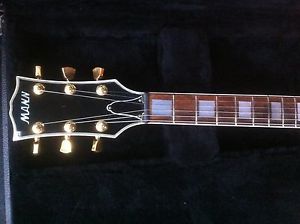Back to the main page Back to category Electric Guitar
musical instrument details
Lawsuit Mann Deluxe black beauty copy- RARE
Estimated price for orientation: 769 $
Category: Electric Guitar
Class:
Description Condition: Used: An item that has been used previously. The item may have some signs of cosmetic wear, but is fully operational and functions as intended. This item may be a floor model or store return that has been used. See the seller’s listing for full details and description of any imperfections. See all condition definitions- opens in a new window or tab ... Read moreabout the condition Brand: mann Body Color: Black Body Type: Solid Body Material: Acrylic Model: les paul Model Year: 1975 String Configuration: 6 String Country/Region of Manufacture: Japan Dexterity: Right-Handed MPN: Does Not Apply
I have a lawsuit mann aka ibanez les paul deluxe black beauty copy. 1 of stock pick ups was replaced with a dimarzzio pickup. the guitar is pristine and sounds great. this is a collector guitar3 way switch. brass finish, mother of pearl inlay on rosewood, moustache headstock, no serial number. made in japan by Fujigen Gakki factory circa mid 70's production. if you know the lawsuit story. as close to a gibson les paul without saying Gibson. to the knowledgeable buyer these are collector pieces. make me an offer or trade for similar price tube amp.you may be aware;Fujigen GakkiMANN guitars were distributed only in Canada by Great West Imports who was headquarted in Vancouver. MANN guitars were sold from approximately 1971 to 1985. The first generation (1971-1976) were made in Japan and there was probably enough inventory to last into the late 1970s. The second generation (1980-1985) were made in Korea.The first generation was closely tied to the Ibanez brand. The early MANN guitars were made in the Fuji-Gen Gakki factory in Japan, the same as Ibanez and many other brands. The "lawsuit" for which all Japanese-built copies of the 70s are somewhat inaccurately named, was over one specific design feature. It demanded that Ibanez stop marketing copies of their guitars, more specifically, the "moustache" headstock that Gibson claimed was their trademark feature. The case was resolved quickly as Ibanez had already redesigned the headstock that was the actual basis and focus of the trademark infringement case. In 1978, Ibanez stopped making copies and began to establish their own iconic guitar designs with the release of the Artist and the Iceman.These guitars are almost identical to the Ibanez models of the same era. This is the era of the lawsuit guitars or technically, pre-lawsuit, where they are direct copies including the headstock shape and design.The second generation was made in Korea and I have no knowledge of the manufacturer. The guitars made during this time vary quite a bit in quality. These are not lawsuit guitars and have no ties to Ibanez.
Description
| Condition: | Used: An item that has been used previously. The item may have some signs of cosmetic wear, but is fully operational and functions as intended. This item may be a floor model or store return that has been used. See the seller’s listing for full details and description of any imperfections. See all condition definitions- opens in a new window or tab ... Read moreabout the condition | Brand: | mann |
| Body Color: | Black | Body Type: | Solid |
| Body Material: | Acrylic | Model: | les paul |
| Model Year: | 1975 | String Configuration: | 6 String |
| Country/Region of Manufacture: | Japan | Dexterity: | Right-Handed |
| MPN: | Does Not Apply |
I have a lawsuit mann aka ibanez les paul deluxe black beauty copy. 1 of stock pick ups was replaced with a dimarzzio pickup. the guitar is pristine and sounds great. this is a collector guitar3 way switch. brass finish, mother of pearl inlay on rosewood, moustache headstock, no serial number. made in japan by Fujigen Gakki factory circa mid 70's production. if you know the lawsuit story. as close to a gibson les paul without saying Gibson. to the knowledgeable buyer these are collector pieces. make me an offer or trade for similar price tube amp.you may be aware;Fujigen GakkiMANN guitars were distributed only in Canada by Great West Imports who was headquarted in Vancouver. MANN guitars were sold from approximately 1971 to 1985. The first generation (1971-1976) were made in Japan and there was probably enough inventory to last into the late 1970s. The second generation (1980-1985) were made in Korea.The first generation was closely tied to the Ibanez brand. The early MANN guitars were made in the Fuji-Gen Gakki factory in Japan, the same as Ibanez and many other brands. The "lawsuit" for which all Japanese-built copies of the 70s are somewhat inaccurately named, was over one specific design feature. It demanded that Ibanez stop marketing copies of their guitars, more specifically, the "moustache" headstock that Gibson claimed was their trademark feature. The case was resolved quickly as Ibanez had already redesigned the headstock that was the actual basis and focus of the trademark infringement case. In 1978, Ibanez stopped making copies and began to establish their own iconic guitar designs with the release of the Artist and the Iceman.These guitars are almost identical to the Ibanez models of the same era. This is the era of the lawsuit guitars or technically, pre-lawsuit, where they are direct copies including the headstock shape and design.The second generation was made in Korea and I have no knowledge of the manufacturer. The guitars made during this time vary quite a bit in quality. These are not lawsuit guitars and have no ties to Ibanez.
